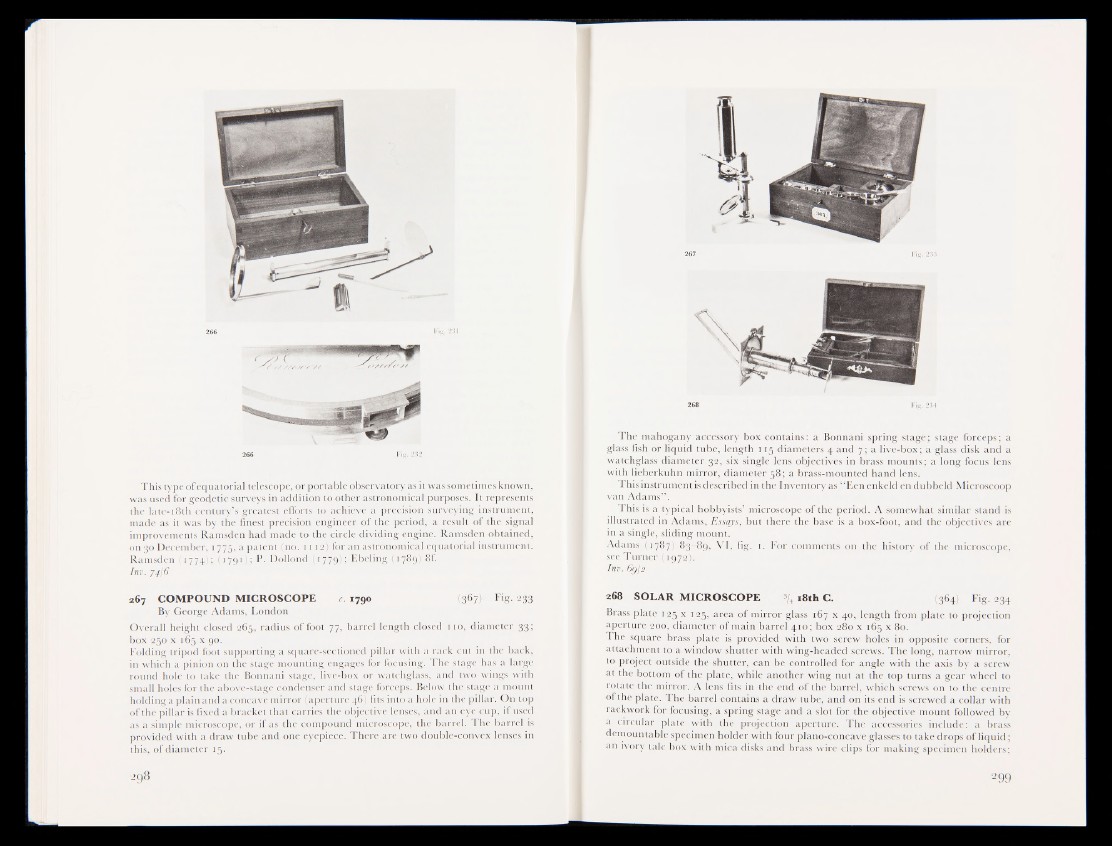
I
This type of equatorial telescope, or portable observatory as it was sometimes known,
was used for geodetic surveys in addition to other astronomical purposes. It represents
the late-18th century’s greatest efforts to achieve a precision surveying instrument,
made as it was by the finest precision engineer of the period, a result of the signal
improvements Ramsden had made to the circle dividing engine. Ramsden obtained,
on 30 December, 1775, a patent (no. 1112) for an astronomical equatorial instrument.
Ramsden (1774); (1791),} P. Dollond (1779) 3 Ebeling (1789) 8f.
Inv. 74/6
267 COMPOUND MICROSCOPE c.. 1790 ||6® Fig. 233
By George Adams, London
Overall height closed 265, radius of foot 77, barrel length closed 110, diameter 33;
box 250 x 165 x 90.
Folding tripod foot supporting a square-sectioned pillar with a rack cut in the back,
in which a pinion on the stage mounting engages for focusing. The stage has a large
round hole to take the Bonnani stageBive-box or watchglass, and two wings with
small holes for the above-stage condenser and stage forceps. Below the stage a mount
holding a plain and a concave mirror (aperture 46) fits into a hole in the pillar. On top
of the pillar is fixed a bracket that carries the objective lenses, and an eye cup, if used
as a simple microscope, or if as the compound microscope, the barrel. The barrifflis
provided with a draw tube and one eyepiece. There are two double-convex lenses in
this, of diameter 15.
The mahogany accessory box contains: a Bonnani spring stage; stage forceps; a
glass fish or liquid tube, length 115 diameters 4 and 7; a live-box; a glass disk and a
watchglass diameter 32, six single lens objectives in brass mounts; a long focus lens
with lieberkuhn mirror, diameter 58; a brass-mounted hand lens.
This instrument is described in the Inventory as “Een enkeld en dubbeld Microscoop
van Adams” .
This is a typical hobbyists’ microscope of the period. A somewhat similar stand is
illustrated in Adams, Essays, but there the base is a box-foot, and the objectives are
in a single, sliding mount.
Adams (178^1 83—89, VI, fig. 1. For comments on the history of the microscope,
sec Turner (1972}..
Inv,, 6M2
268 SOLAR MICROSCOPE •'% 18th C. (364) Fig. 234
Brass plate 125 x 125, area of mirror glass 167 x 40, length from plate to projection
aperture 200, diameter of main barrel 410; box 280 x 165 x 80.
The square brass plate is provided with two screw holes in opposite corners, for
attachment to a window shutter with wing-headed screws. The long, narrow mirror,
to project outside the shutter, can be controlled for angle with the axis by a screw
at the bottom of the plate, while another wing nut at the top turns a gear wheel to
rotate the mirror. A lens fits in the end of the barrel, which screws on to the centre
of the plate. The barrel contains a draw tube, and on its end is screwed a collar with
rackwork for focusing, a spring stage and a slot for the objective mount followed by
a circular plate with the projection aperture. The accessories include: a brass
demountable specimen holder with four plano-concave glasses to take drops of liquid;
an ivory talc box with mica disks and brass wire clips for making specimen holders;